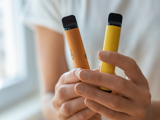
Vaping & Protege: Mitigation through detection
Statistics show a year over year increase in vaping trends amongst adolescents and with schools’ obligation to keep students safe and healthy, many are wondering what can be done.
But first things first:
What is vaping?
Vaping is the use of an electronic device to heat a liquid, turning it into a vapor, which is then inhaled by the user.
Vaping trends: what’s the concern?
Whether it’s in class, hallways, or hidden away in the bathrooms, vaping has only risen in prominence over the last few years.
Surveys show New Zealand and Canada have some of the highest rates, with 26% of adolescents regularly vaping in each region. In Australia, rates have tripled since 2019 to 14% of students, while The National Youth Tobacco Survey in the United States found a whopping 2.5 million high and middle school students – or 17% - are currently vaping.


More than the rates, it’s what’s in the vapes and the potential vaping side effects that are causing concern. Preliminary studies from the Schulich School of Medicine & Dentistry and the Lawson Health Research Institute show that vaping negatively impacts the lipids and proteins that are critical for normal, healthy lung function, making users more vulnerable to lung injury, including respiratory illnesses like the flu.
This can be worsened by popular flavors like mint or menthol. These flavors have seen explosive growth in the last few years, rising from 1.5 million units sold in 2017 to 12 million in 2021, and are shown to cause worse health outcomes due to particles ingested from the menthol. These types of “kid-friendly” flavors are directly linked to rising youth vaping statistics, with 70% saying they would quit vaping if menthol, fruit, and candy flavors were banned.
The result that vapes have on students developing brains can be detrimental, with professors and doctors noting that the reward pathways in the brain can easily become linked to the dopamine hit you get from vapes, resulting in more frequent use and higher distraction. And as you continue to vape, your tolerance increases, resulting in the need for more and more vaping as the dopamine becomes harder to get.

What can be done?
As previously noted, schools have a responsibility to ensure the welfare of their students. But teachers and campus police cannot be everywhere and with school staff already stretched thin, it is increasingly difficult to stop.
By integrating Protege with a third-party sensor, like schools in the United States are doing with sensors such as Halo Smart Sensors, school staff can be notified within the status pages and floor plans of the Protege system, and even receive push notifications right to their phones, when the sensor picks up vapor.
This is all done by a simple output connection, resulting in one seamless solution for access control, security, and student wellbeing.
Protege is a proven solution for K-12 and higher educational institutions, enabling security and school management to seamlessly adapt their systems to meet threats as they arise. In the case of the growing vaping epidemic Protege can pair with third-parties who produce advanced Vape sensor technology.

Funding
Schools work on limited resources, including money. However, your school may qualify for grants or funding from local or federal/central government. We have compiled a few resources for you depending on your region:
If your region hasn’t made funding available, we recommend looking to corporate sponsorship, non-profit organizations, or even your parent-teacher association.











